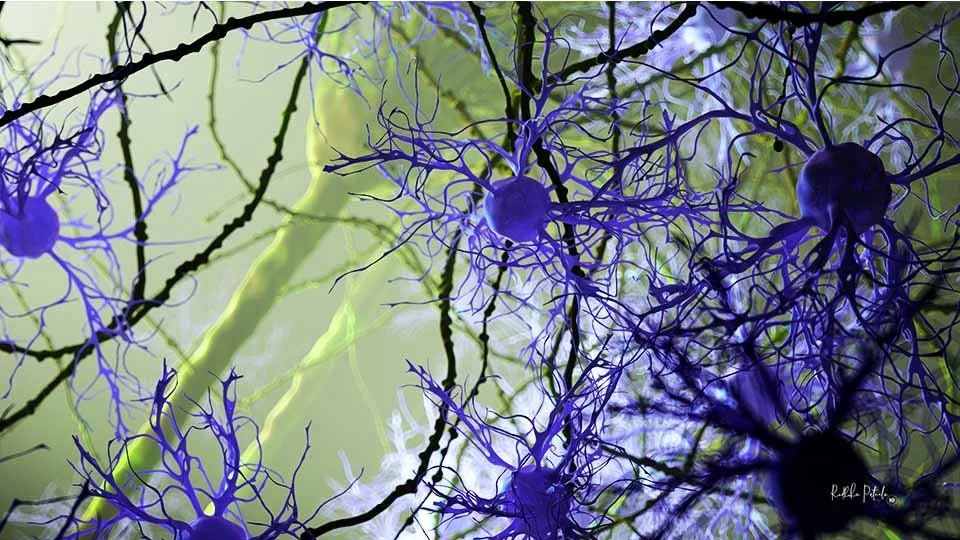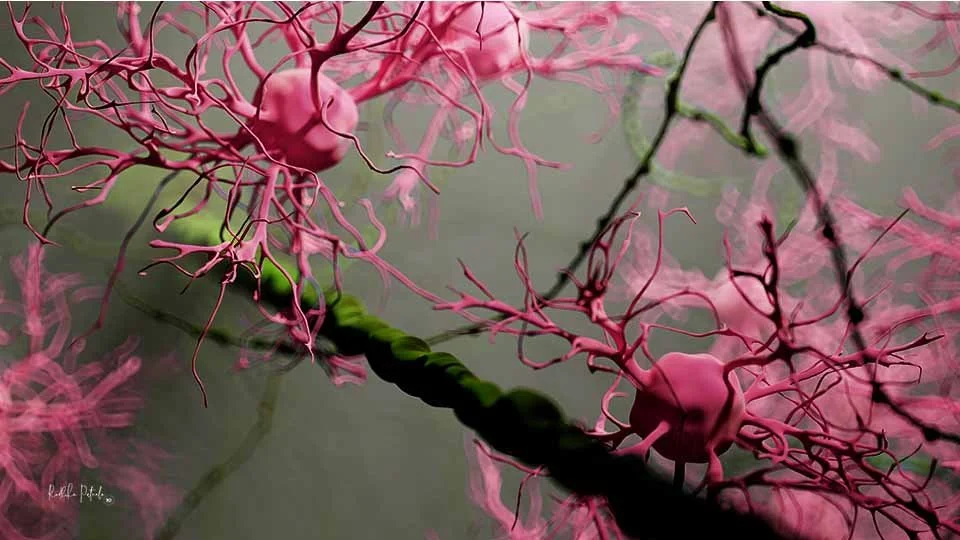
Microglia in spring
Microglia are the brain's primary immune cells, constantly surveying their environment with their branching processes, maintaining, protecting.
I was always impressed by how multifunctional these cells are, dynamically responding to their environment - pruning neural connections, clearing cellular debris, and protecting our brain's delicate ecosystem.
In developing this series "Microglia in Spring," I want to capture my love for the beauty of nature, both inside and outside our minds.
As always, you can take them home as 4K wallpapers. Spring doesn’t have to end just yet.
Dr. Radhika Patnala

Wisteria Dawns
A gentle activation as they begin their daily monitoring routine throughout the neural environment. During this awakening phase, microglial cells begin to increase their motility, extending their surveillance processes to the neuronal environment within their reach, clearing debris, and modulating synaptic connections.
A selection of microglial landscapes in Hi-res 4K wallpapers with 15 variations available for free download. PS: For personal use as screen wallpapers only. No other use, personal or commercial permitted for this series. 















Lilac MORNINGS
During morning hours, microglial cells fully engage their surveillance machinery. Their processes extend and retract continuously, sampling their microenvironment and making contact with thousands of synapses through specialized receptors that detect subtle changes in neural activity.
This morning surveillance allows microglia to monitor synaptic health, assess neuronal function, and provide trophic factors that support cognitive activities ramping up for the day.
A selection of microglial landscapes in Hi-res 4K wallpapers with 15 variations available for free download. PS: For personal use as screen wallpapers only. No other use, personal or commercial permitted for this series. 















Cherry Blossom noons
By midday, microglia reach their highest metabolic and functional activity, perfectly aligned with our peak cognitive performance. These adaptive cells respond to the increased neural firing and metabolic demands by enhancing their capacity to clear byproducts of neural activity, including excess neurotransmitters and metabolic waste.
Midday microglia show upregulated expression of receptors involved in glutamate sensing and inflammatory response modulation, allowing them to rapidly respond to the brain's heightened activity.
A selection of microglial landscapes in Hi-res 4K wallpapers with 15 variations available for free download. PS: For personal use as screen wallpapers only. No other use, personal or commercial permitted for this series. 















PLUM Blossom sunsets
Microglia begin a fascinating transitional phase, shifting from their daytime surveillance role toward preparations for nocturnal brain maintenance. These cells modify their gene expression patterns to upregulate pathways involved in phagocytosis (cellular cleanup) and tissue repair while downregulating inflammatory response genes.
Evening microglia begin to secrete factors that enhance synaptic plasticity, supporting the memory consolidation processes that will occur during sleep. Their branching processes become more exploratory and less reactive, preparing the neural environment for the important restorative work of the night ahead.
A selection of microglial landscapes in Hi-res 4K wallpapers with 15 variations available for free download. PS: For personal use as screen wallpapers only. No other use, personal or commercial permitted for this series. 















Magnolia evenings
As evening approaches, microglia transition into a distinctly restorative functional state. Neuroscience research has revealed that these cells begin to increase expression of growth factors like BDNF and IGF-1 that support neuronal health while preparing the extracellular matrix for the enhanced clearance activities of sleep.
Microglia coordinate with astrocytes to regulate the brain's extracellular space, gradually expanding these channels to facilitate the improved flow of cerebrospinal fluid that will occur during deep sleep. Their processes become more deliberate in their movements, focusing on areas that accumulated metabolic byproducts during the day's activities.
A selection of microglial landscapes in Hi-res 4K wallpapers with 15 variations available for free download. PS: For personal use as screen wallpapers only. No other use, personal or commercial permitted for this series. 















PEACH NIGHTS
During deep sleep, microglia undergo their most dramatic functional transformation, becoming the primary orchestrators of the brain's nightly cleaning cycles. These cells coordinate with astrocytes to facilitate the glymphatic system - the brain's waste clearance pathway that activates during sleep.
Nighttime microglia show enhanced phagocytic activity, efficiently engulfing protein aggregates, cellular debris, and damaged synaptic components that accumulated throughout the day. They secrete proteolytic enzymes that break down potentially harmful substances while releasing anti-inflammatory factors that help restore neural tissue. Studies show these cells even assist in synaptic remodeling during sleep, pruning less efficient connections and strengthening those associated with important memories.
A selection of microglial landscapes in Hi-res 4K wallpapers with 15 variations available for free download. PS: For personal use as screen wallpapers only. No other use, personal or commercial permitted for this series.














PS: For personal use as screen wallpapers only. No other use, personal or commercial permitted for this series. I quite enjoyed spring this year. Especially the cherry blossoms, and the flowers in the backdrop of changing skies from bright blue to cloudy grey. I put my heart and soul into making these works of art.
If you enjoyed them, do drop me a line and make my day :), Radhika